Related Research Articles

Jharkhand is a state in eastern India. The state shares its border with the states of West Bengal to the east, Chhattisgarh to the west, Uttar Pradesh to the northwest, Bihar to the north and Odisha to the south. It has an area of 79,716 km2 (30,779 sq mi). It is the 15th largest state by area, and the 14th largest by population. Hindi is the official language of the state. The city of Ranchi is its capital and Dumka its sub-capital. The state is known for its waterfalls, hills and holy places; Baidyanath Dham, Parasnath, Dewri and Rajrappa are major religious sites.
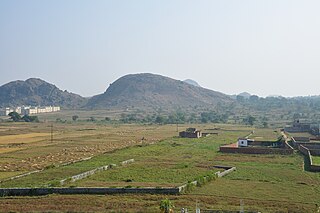
The Chota Nagpur Plateau is a plateau in eastern India, which covers much of Jharkhand state as well as adjacent parts of Chhattisgarh, Odisha, West Bengal and Bihar. The Indo-Gangetic plain lies to the north and east of the plateau, and the basin of the Mahanadi river lies to the south. The total area of the Chota Nagpur Plateau is approximately 65,000 square kilometres (25,000 sq mi).

Son River is a perennial river located in central India. It originates near Amarkantak Hill in Gaurela-Pendra-Marwahi district of Chhattisgarh and finally merges with the Ganges River near Patna in Bihar. The Sone River is the second-largest southern tributary of the Ganges after the Yamuna River. India's oldest river bridge Koilwar Bridge over Sone River connects Arrah with Patna. Sone river is famous for its sand across country. Multiple dam(s) and hydro-electric projects run on its course towards Ganges.
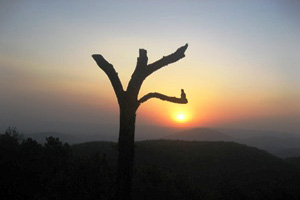
Netarhat is a hill station in Latehar district in the Indian state of Jharkhand. It is also referred to as the "Queen of Chotanagpur", and is a hill station. The town is also famous for Netarhat Residential School, set up in 1954.
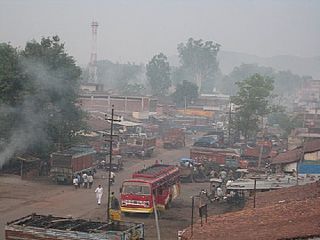
Latehar is a town which is a headquarter of Latehar district of Jharkhand state, it is known for its natural environment, forest, forest products and mineral deposits. Latehar remained a part of Palamau District as a sub division since 1924. It was elevated from sub divisional status to a district on 4 April 2001, vide Jharkhand Government Notification No 946 dated 04.04.2001. Latehar is located on the north–west corner of Jharkhand in the Palamau Commissionary. It is surrounded by Ranchi, Lohardaga, Gumla, Palamu and Chatra district apart from Chhattisgarh state and district headquarters is situated at 84.51198 East Longitude and 23.741988 North Latitude.
Garhwa is a town and a municipality in, and headquarters of, Garhwa district in the state of Jharkhand, India. Uttar Pradesh, Chhattisgarh and Bihar are nearby states. Garhwa Road (Rehla) is a major Railway Junction where thousands of passengers find this station most convenient to catch their train for Delhi and Kolkata. You can find bus services for Ranchi, Ambikapur, Gaya etc.

Palamu district is one of the twenty-four districts of Jharkhand, India. It was formed in 1892. The administrative headquarters of the district is Medininagar, situated on the Koel River.
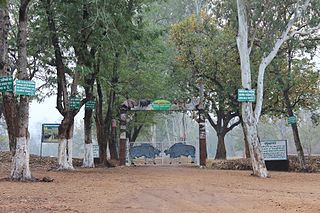
Betla National Park is a national park located on the Chota Nagpur Plateau in the Latehar and Palamu district of Jharkhand, India. The park hosts a wide variety of wildlife.
Barwadih is a town and Community Development Block in Latehar district of Jharkhand state in India.
The Palamau Tiger Reserve is one of the nine original tiger reserves in Jharkhand, India and the only one in this state. It forms part of Betla National Park and Palamau Wildlife Sanctuary. As of 2022, the reserve is reported to be largely under Naxal control.
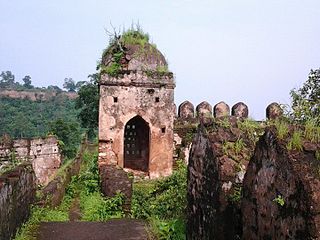
The Palamu fort are two ruined forts located 3 k.m from Betla National Park, Latehar district on the bank of Auranga River, in the Indian state of Jharkhand. The old fort in the plains, which existed even before the Chero dynasty, was built by the King of Raksel dynasty. The original fort in the plains and the other on an adjoining hill are attributed to the kings of the Chero dynasty. The fort in the plains had defences on three sides and three main gates. The New fort was constructed by Raja Medini Ray. East India company used this fort to prison Narayan Peshwa of Tiroha and Raja Radhkrishna alis Subedar Aftab Singh mutineers of 1857.
The Burha River flows through the Latehar district of Palamu division in the Indian state of Jharkhand.
The Auranga River flows through the Latehar and Palamu districts in the Indian state of Jharkhand.

The Punpun River is a tributary of the Ganges. It originates in Palamu district of Jharkhand and flows through Chatra, Aurangabad, Gaya and Patna districts of the Indian states of Jharkhand and Bihar. Punpun is a place named after the Punpun river in Patna which is situated on the bank of Punpun river. On the bank of Punpun people celebrate Chhath Puja.
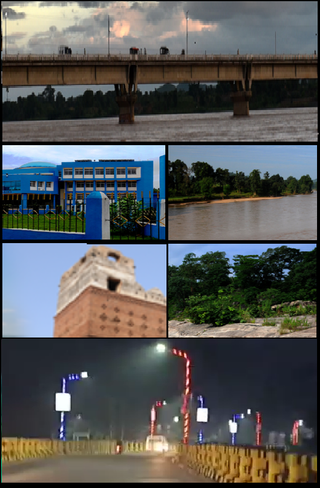
Medininagar, formerly Daltonganj, is a city municipal corporation in the Indian state of Jharkhand. It is the headquarters of Palamu division and Palamu district, as well as the subdivision and block of the same name. The city is situated on the banks of the North Koel River.
Daltonganj railway station, station code DTO, is a railway station serving the cities of Medininagar and Palamu in Palamu district of the Indian state of Jharkhand. Daltonganj station is also the headquarters of the Palamu division of the East Central Railway Zone of the Indian Railways. It is also a major station on the CIC route and will be a primary hub on the Ranchi–New Delhi route after the opening of the Ranchi–Tori rail line. Major trains such as the Ranchi Rajdhani Express, Muri Express, Sambalpur–Varanasi Express, Palamu Express, Ranchi–Varanasi Express, Ranchi–Ajmer Garib Nawaz Express, Triveni Express, Ahmedabad Kolkata Express, Jharkhand Swarna Jayanti Express, Jharkhand Sampark Kranti Express, and Shaktipunj Express also stop here.

The following outline is provided as an overview of and topical guide to Jharkhand:
The 13347 / 13348 Palamu Express is an Express train belonging to East Central Railway zone that runs between Barkakana Junction and Patna Junction in India. It is currently being operated with 13347/13348 train numbers on a daily basis.
Naudiha is a village in Naudiha Bazar block in Palamu District of Jharkhand, India. It is located 62 km from district headquarters Daltonganj and 201 km from the state capital Ranchi. Naudiha is surrounded by Hariharganj Block towards North, Dumaria Block towards East, Patan Block towards South, Hussainabad Block towards west. Naudiha Population
Rajhara Area is one of the operational areas of the Central Coalfields Limited located in the Palamu and Latehar districts in the state of Jharkhand, India.
References
- 1 2 3 4 "Gazetteer of Palamu District" . Retrieved 29 April 2010.
- ↑ "Betla National Park" . Retrieved 29 April 2010.
- ↑ "River System" (PDF). Retrieved 29 April 2010.
- ↑ "Projects in Jharkhand". North Koel Hydroelectric Project. Retrieved 29 April 2010.
- ↑ "Inter State Issues". North Koel Project. Retrieved 29 April 2010.
- ↑ "Project Tiger Reserves in India". Palamu Tiger Reserve. Archived from the original on 7 February 2010. Retrieved 29 April 2010.
- ↑ "JAVADEKAR VOWS TO MAKE KUTKU DAM OPERATIONAL".